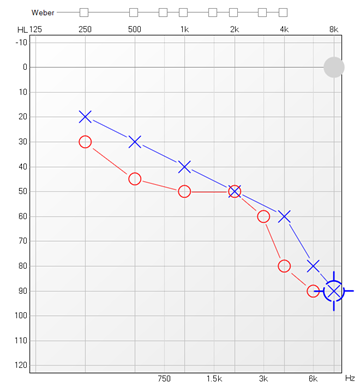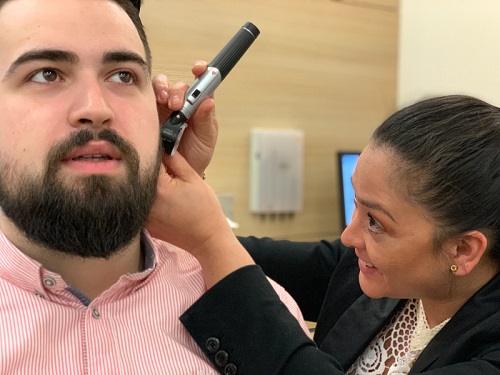What is an audiogram?
During a hearing test your hearing specialist will create a graphic representation of your hearing abilities called an audiogram.
If you want to find out whether your hearing is still working well, or if you have hearing loss, you should have your hearing tested by a specialist. The specialist performs a hearing evaluation and creates an audiogram from the results. This is a diagram that is used to assess a person’s hearing ability. What does an audiogram look like? How is it created? How is it read? You can find answers to the most frequently asked questions as well as more information on hearing tests and audiometry below.
What is an audiogram?
A hearing test that is performed at a hearing clinic covers a number of examinations that indicate whether or not you have hearing loss. The results of a hearing test are represented in the form of an audiogram.
The hearing care professional can use the audiogram to identify whether you have hearing loss, and determine the extent of the hearing loss if the finding is positive. If you have hearing loss, your local professional will explain the result of the audiogram to you.
The audiogram illustrates your hearing by representing your hearing threshold levels
at different frequencies. The hearing threshold levels show the point at which a tone can be perceived. A hearing threshold level of between 0 and 25 dB is normal. This means 0 dB for a young person with normal hearing.

How is an audiogram created?
During a professional hearing test, an audiogram is created using an audiometer. For this, the hearing care professional or audiologist plays a specific sound to the client through headphones during the hearing test. The individual sounds start at a very quiet level and gradually become louder. The reading is taken for each ear individually. The quietest sound that a person can hear is identified by this frequency and intensity. This combination of frequency and intensity is called the hearing threshold level. The audiogram is a reflection of your hearing ability. It shows how far your hearing ability deviates from normal hearing ability, and, if there is a discrepancy, what the cause of the hearing loss might be.
Deviations may take various forms and have various degrees of severity. Depending on the part of the ear that is affected, four main types of hearing loss can be distinguished:
- Conductive hearing loss,
- sensorineural hearing loss,
- combined hearing loss,
- and neural hearing loss.
The tone audiometry is followed by a speech audiometry (speech intelligibility test). This determines the extent to which hearing loss affects the understanding of speech.
Discomfort threshold in speech audiometry
A discomfort threshold is determined during the speech and tone audiometry. For this, words, numbers, or tones are played at a high volume until it becomes uncomfortable for the client. This is to check whether the threshold is in the normal area.
An audiologist can determine whether you have hearing loss and tell you about the options for compensating for it.
Please note:
An online hearing test can never be a replacement for a professional hearing examination. It is important to seek the opinion of a licensed hearing care professional or audiologist.
Hearing test evaluation: How is an audiogram read?
An audiogram features two axes. Loudness and intensity can be read on the vertical axis. These are measured in decibels (dB). The lower the point on the axis, the louder the tone. The quietest tone (0 dB) is at the top of the axis. A person can normally still hear this tone.
Tone frequency and pitch are read along the horizontal axis. This is measured in Hertz (Hz). The further right along the axis, the higher the frequency. This direction is similar to a piano: The further right the key, the higher the tone. The frequency of a normal conversation is between 500 Hz and 3,000 Hz.
During a hearing test, the results are recorded on the audiogram using a red mark for the right ear and a blue mark for the left ear. Connecting these marks results in lines that show the hearing threshold level for each ear. It is quite possible to obtain different results for each ear.
As a general rule, the further the hearing curve is from the line of the normal hearing range, the greater the hearing loss.
What are decibels?
Sound level is measured in decibels (dB) using the decibel scale. The decibel scale is a logarithmic scale in which the doubling of the sound pressure level corresponds to a level increase of 6 dB. Decibels are not fixed values like volts or meters. The value of a dB depends on the respective context. It is not only used to measure the sound level, but also in antenna technology or radar metrology.
Here are some examples of different volumes, measured in decibels:
- 180 dB: a rocket launch
- 140 dB: a jet plane
- 120 dB: a rock band
- 110 dB: loud thunder
- 90 dB: city traffic
- 80 dB: a loud radio
- 60 dB: a conversation at normal volume
- 30 dB: whispering
- 0 dB: the quietest sound that can be heard by the human ear
What are frequencies?
Tone frequency is the number of vibrations in a sound wave per second. The unit of measurement is the Hertz (Hz). The higher the number, the higher the frequency. Vibrations between 20 and 20,000 Hertz are interpreted as sounds by the average person. The twittering of birds is one example of a high tone. Low tones include distant thunder or a tone on a bass guitar.
High-frequency hearing loss means that the affected person has problems starting with impairment in the higher frequencies only. These include sibilants (-s-, -f-, or –sh-) and consonants. Those affected find it difficult to hear tones with high frequencies, such as doorbells and telephones, or children’s voices. Lower frequencies also become harder to perceive as the hearing loss progresses.
Other Topics
VAC, WCB, WSIB, WorkSafeBC, ADP & ODSP accepted. *Hearing evaluations/tests are free for customers over the age of 18. Fees may apply where specific testing for employment purposes, reports, a copy of your results or the completion of an application is required. See clinic for full details.





